Analog vs. Digital Watches: Which Watch Is Best for You?
2nd Mar 2022
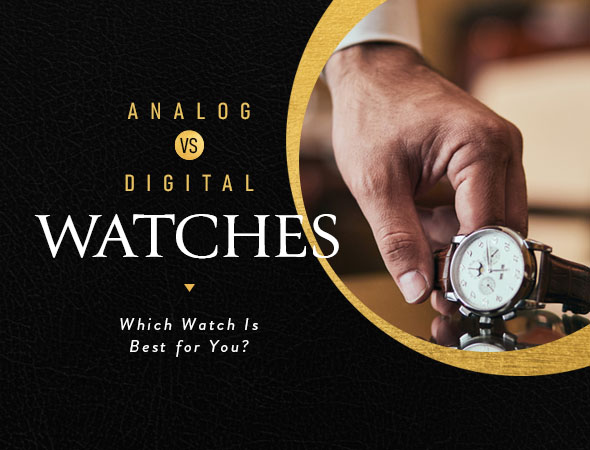
It’s easy to get lost in the huge variety of watches on the market. One way to narrow down your search is figuring out whether you want an analog or digital watch. Analog watches display the time with hand and hour indicators, while digital watches numerically display the time on an LED screen. The watch best suited for your needs depends on what you want from a watch. Consider the watch’s movement, display, features, and cost to determine if you need a classic analog watch from a luxury watch brand or a futuristic digital watch full of features.
Discover Our Collection of Authentic Watches
Movements Matter
A watch’s movement is the internal mechanism that powers the watch and keeps track of time. The primary difference between digital and analog watches is their movement. A digital watch uses batteries and a quartz stone in its movement. Analog watches can also use quartz, but mechanical movements are often employed in high-end brands like Rolex.
Digital quartz movements
The movement inside a digital watch consists of a small quartz crystal, two circuits, a battery, and a microchip. The time-tracking process begins with the battery sending electricity through the quartz crystal. Electricity forces quartz to slightly disfigure, but the quartz returns to its normal shape when electricity is absent. This happens at an extremely fast rate, so the quartz appears to vibrate. When exposed to a consistent amount of electricity, the quartz crystal vibrates consistently at 32,768 vibrations per second.
The vibrating quartz crystal is monitored by the first of a digital watch’s circuits. Every 32,768 vibrations, the first circuit sends an electric pulse to the counter circuit. The counter circuit converts the electric pulse into binary data. The watch’s microchip converts the binary data into hours, minutes, and seconds with predetermined calculations. The microchip sends the time data to the display screen, which tells the user the time. Digital quartz movements lose about 20 seconds of accuracy every month because of how environmental factors affect the quartz vibration. Heat and low air pressure result in slightly faster crystal vibration. Cold and high air pressure slightly reduce the vibration frequency.
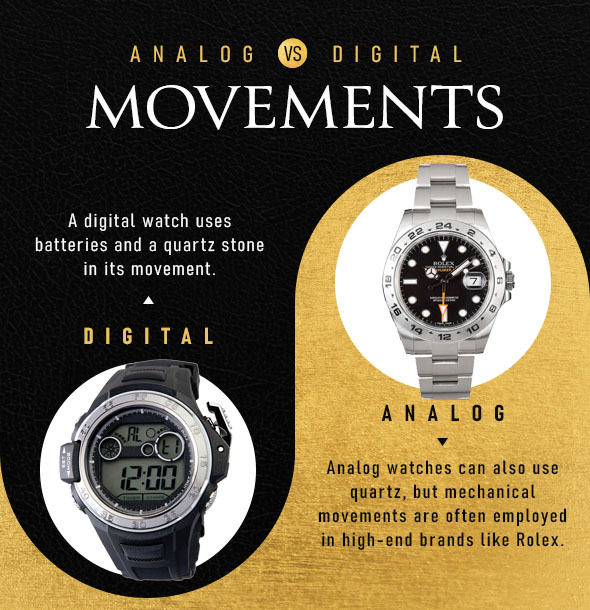
Analog quartz movements
While the luxury watch brands predominantly use automatic mechanical movements, you can also find high-end quartz movement watches like the Hublot Big Bang 361.CM.7170.LR.1204. This quartz movement analog watch combines a diamond bezel with a blue leather bracelet and blue dial for a distinct and flashy appearance.
Quartz movements in analog watches function the same as digital watches at the beginning of the process but what the watch does with the quartz vibration is different. Like a digital watch, the quartz crystal vibrates when the battery sends electricity to it. The vibration is monitored by a circuit that creates an electric pulse every 32,768 vibrations. At this point, digital and analog watch movements diverge.
The one-second-interval electric pulses power an electric stepping motor. Stepping motors convert electrical energy into mechanical energy by rotating a motor shaft a precise amount when exposed to a specific amount of electricity. The stepping motor shaft rotation turns the gears of the watch. As gears turn, the second, minute, and hour dials rotate to show the user the time.
Analog mechanical movements
Before the introduction of quartz to the watch world, mechanical movements were the only way to keep track of time. Now they are the preferred movement of watch connoisseurs because a mechanical movement requires precision and craftsmanship absent in quartz movements. Current mechanical movements are the natural evolution of hundreds of years of watchmaking, giving mechanical watches historical significance that collectors love.
Mechanical movements are either automatic or manual. Both types use the same mechanical parts to move the hands, but they differ in how they create power for the watch. In an automatic watch, the wearer’s movement creates kinetic energy, making the watch’s semi-circular rotor move. The rotor’s movement causes gears to move, and those gears’ movements wind the watch’s power source: the mainspring.
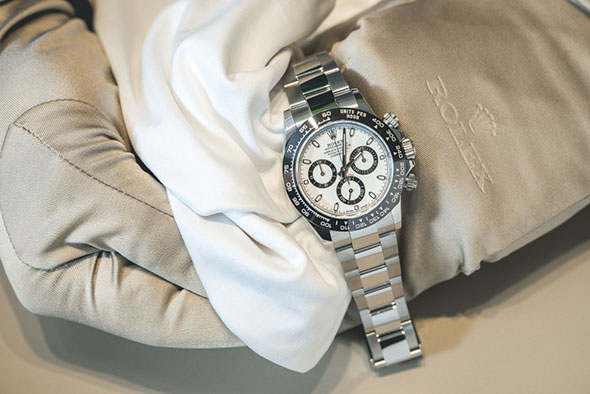
Manual movements require the wearer to wind the mainspring by rotating the watch’s crown. Other than the process that leads to the winding of the mainspring, automatic and manual mechanical movements are the same. The wound mainspring is the power source for the watch because it slowly and consistently releases energy as it unwinds—the energy transfers into gears that rotate and transfer the energy to the escapement.
From the escapment further energy transfers occur through the balance wheel and final geartrain. The geartrain’s consistent movement turns the hands on the watch. Mechanical movements are more complicated to build, often requiring hundreds of components to be hand-assembled. This dedicated craftsmanship makes them a worthwhile purchase for a collector.
Differences in Display
The watch’s display is the user interface. It shows the user what time it is as determined by its movement. While many people care deeply about the movement of their watches, it is the display that sets watches apart. Digital watches use LCD or LED displays, while analog watches use hands and indices to display the time.
Digital displays
When fed time data from the computer chip within the watch’s movement, a digital display shows time in characters. Digital watches also usually display the day of the week and the date. Most digital displays prioritize legibility with high-contrast designs and large numbers.
Some more style-focused digital displays mix analog features with digital numbers. They come with hands and hour indices and digital displays of time, date, and day of the week. Recent developments in smartwatches may also be considered digital watches. Their displays feature high-resolution touchscreens that give users access to multiple downloadable apps. While style is not entirely forgotten in digital displays, functionality is often more important than the watch’s form. A digital display must accommodate stopwatches, alarms, and much more if it is a smartwatch, such as biometric data and video.
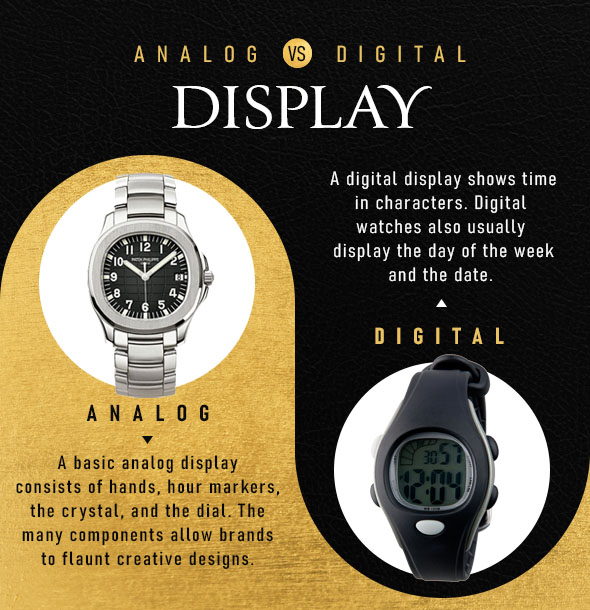
Analog displays
A basic analog display consists of hands, hour markers, the crystal, and the dial. The hands and hour markers indicate the time and are housed in the dial. The crystal is the transparent outer casing that protects the display. Many analog watches add more features to the display, such as a date window, a cyclops lens, an ornamental bezel, and subdials. The many components of an analog display allow watch brands to flaunt creative designs.
A balance of style and functionality is crucial for an analog display. For instance, the luxury watch brand Patek Philippe earned its prestigious reputation by creating elegant and sporty watches for the past 180 years. The Patek Philippe Aquanaut 5167A-001 is the brand’s answer to the rising demand for stainless-steel sports watches. It has a stainless-steel bracelet and a 40mm stainless-steel case and bezel. The black dial contrasts with the stainless steel and has a geosphere design that gives the watch a sleek, streamlined appearance—ideal for everyday wear.
On the other end of the display-style spectrum is the Patek Philippe Complications collection. These analog watches push the limits of analog functionality and display with moon-phase displays, day/night indicators, perpetual calendars, and more. What makes these displays and functions so impressive are all the complications they add to the watches’ movements. Every extra indicator requires unique gears and extra power supply.
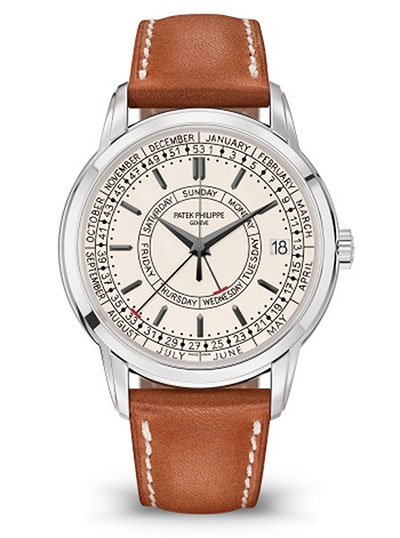
The Patek Philippe Complications 5212A-001 is the Complications model for the modern businessman. It tells the day of the week, the day of the month, the week of the year, the month of the year, and, of course, the time of the day. The complications are housed in a silver dial with darkened gold hour indices. This analog watch exemplifies the great potential for unique designs inherent in the analog display. Plus, it shows that functionality can accompany design in unique ways that digital watches can not compare to.
Price Differences
There is a huge variation in watch prices between analog and digital models. While you can purchase a relatively high-quality digital watch for under $50, many of the best analog timepieces cost several thousand dollars. Several factors contribute to the cost of a watch, including the materials used, the labor, the complexity of the movement, and additional features. The brand name and the market demand for the watch also influence the price, especially for vintage or rare timepieces.
Digital watch prices
Digital watches feature quartz movements that are all relatively similar. The components are typically machined and manufactured in bulk, and then assembled in a factory. Companies produce millions of units each year, which means supply usually outstrips demand, keeping digital watch prices low.
The main factors influencing digital watch prices are materials and extra features. Newer smartwatches and timepieces with integrated fitness trackers or GPS are highly popular. But the additional software, electrical components, and high-performance strap and case materials required means watches like the Apple Watch or G-Shock cost over $1,000. The issue with digital watches is that they don’t hold their value like an analog watch. There is also less demand with collectors, so it can be challenging to get a fair resale price if you want to buy a digital watch as an investment.
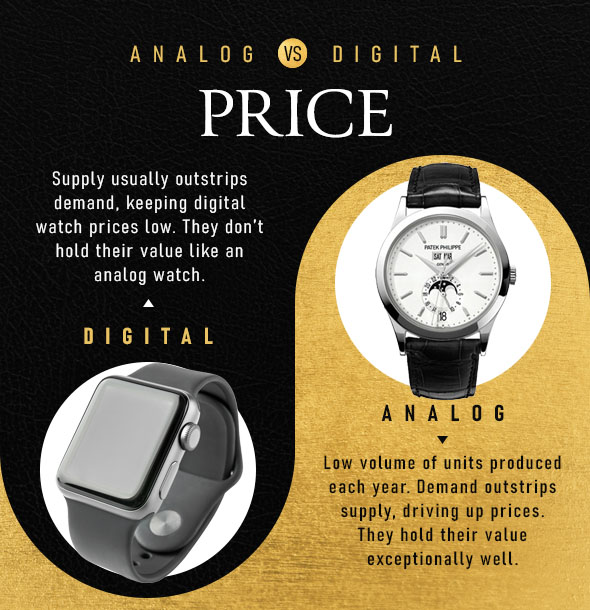
Analog watch prices
High-end analog watches can cost thousands of dollars, and even millions at auction. Paul Newman’s famous Rolex Cosmograph Daytona sold for $17.8 million, while the Patek Philippe Grandmaster Chime fetched a whopping $31 million. Analog watches have a more complex internal mechanism than digital models. Many of the movement’s components must be machined and assembled by hand, requiring hundreds of hours of labor for a single timepiece.
Many watchmaking brands develop and patent their own luxurious materials to craft their watches. Rolex has a dedicated R&D team responsible for creating its Oystersteel and Rolesor metals. Cases and bezels can often be embedded with precious gems, such as diamonds or sapphires, which adds to the overall cost.
Market demand for luxury analog watches is extremely high; however, due to the labor-intensive nature of analog watch production, most companies only produce a low volume of units each year. This means that demand nearly always outstrips supply, driving up prices. However, a high-quality analog watch from a prestigious brand represents an excellent investment piece as well as a stylish accessory. Luxury watches, such as Rolex and Audemars Piguet, hold their value exceptionally well and can become treasured family heirlooms.
Shop Pre-Owned Luxury Analog Watches at Luxury of Watches
Watch Features
Digital and analog watches both offer several additional features. A digital watch powered by a quartz mechanism can track your workout with a stopwatch and lap-recording capabilities. It can monitor your heart rate, track your speed, tell you what direction you are going with a compass, and much more. With advancing technology and the introduction of smartwatches, digital watches can now access the internet, text, and make calls.
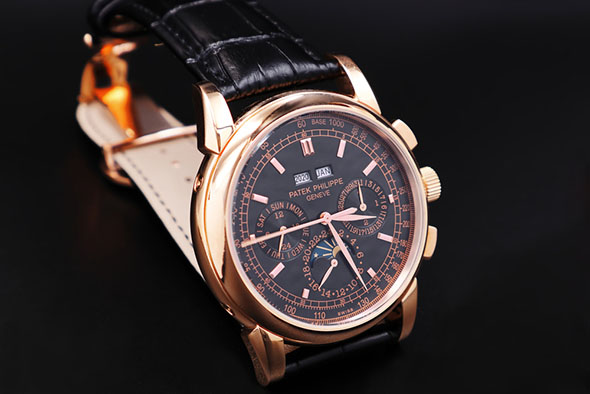
Analog watches provide a stopwatch, multiple time zones, moon cycles, and more, but each added function substantially increases the price. More functions mean more display features and more movement complications. In mechanical movements especially, the more functions a watch has, the more craftsmanship goes into its creation. Rather than downloading software to a digital watch, an analog timepiece with multiple functions represents hours of labor and precision.
While digital watches can support more features, the features in an analog watch add more value to watches. Whether it is because of the complicated movement or the craftsmanship necessary to create the movement, the features in an analog watch earn admiration from watch collectors and horologists alike.
Picking the Watch for You
The best watch for you depends on why you want a watch. If you need a watch purely for functionality, then a digital watch is a good choice. However, if you want a timepiece that is more than just a timekeeping accessory, you need an analog watch. Analog watches from luxury watch brands take advantage of the classic analog display and connect you with history through their mechanical movements. While they cost more than digital watches, luxury analog watches hold value and double as an investment.
Luxury of Watches has the perfect watch for you. Browse our catalog, which includes luxury timepieces from Rolex, Cartier, Breitling, and more. Contact us for more information about our selection of watches.
Image Credits
Arayan Rattanaphan/Shutterstock.com
Disorder_Vortex/Shutterstock.com
John Kasawa/Shutterstock.com
Sergey Eremin/Shutterstock.com
BONDART PHOTOGRAPHY/Shutterstock.com
S-Studio/Shutterstock.com
Rustic and Watches/Shutterstock.com
